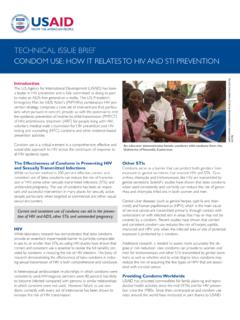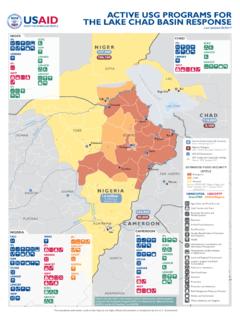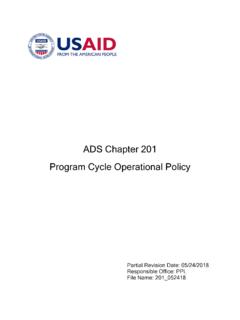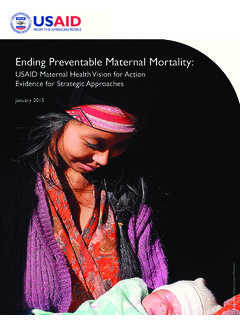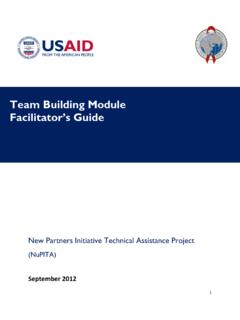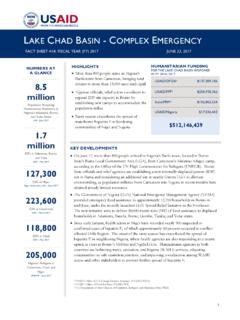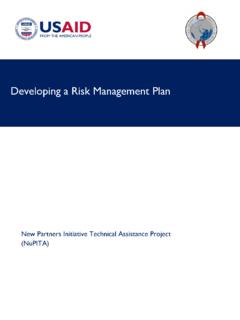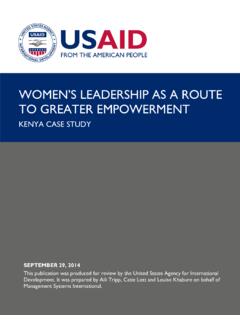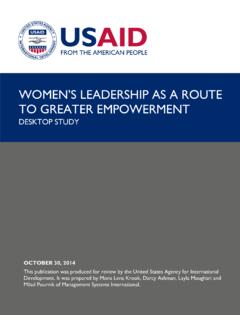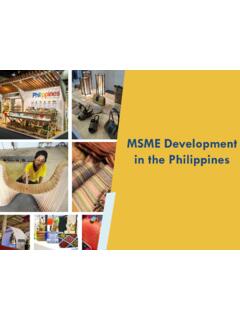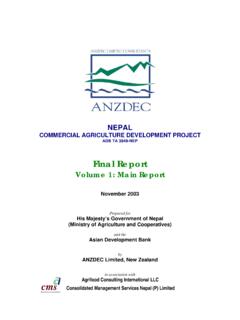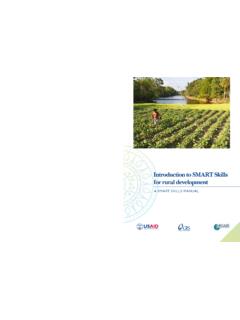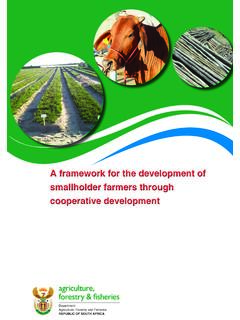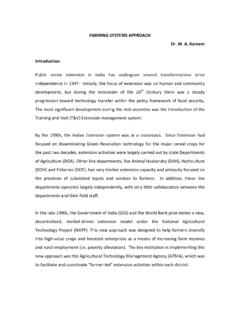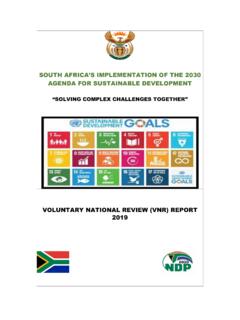Transcription of Next Stage for Dairy Development in Ethiopia
1 The NEXT Stage IN Dairy Development FOR Ethiopia Dairy Value Chains, End Markets and Food Security Cooperative Agreement 663-A-00-05-00431-00 Submitted by Land O'Lakes, Inc. Box 3099 code 1250, Addis Ababa, Ethiopia November 2010 2 Ethiopia Dairy Value Chains, USAID CA No. 663 A 00 05 00431 00 Land O Lakes, Inc. IDD. TABLE OF CONTENT Pages 5 EXECUTIVE SUMMARY .. 6 1. OVERVIEW OF THE Dairy SUB-SECTOR The Role of the Dairy Sub-Sector in the Economy of Ethiopia Milk Production and its Allocation Livestock and Milk in the household economy The Challenges A Value Chain Approach The Tasks and the Study Team 2. DEMAND FOR MILK AND MILK 15 Milk Consumption Milk and Milk Product Consumption in Urban Areas Milk and Milk Product Consumption in Rural Areas Milk and Milk Product Consumption in Pastoral Areas Milk Consumption Compared to Other Countries Milk s Role for Food Security and Household Nutrition Consumption of Imported Milk Products by Areas and Product Categories domestic and imported Milk Consumption in 2020 High Estimate Middle of the Range Estimate Low Estimate Assessment 3.
2 Dairy 30 Current Situation Milk Production Areas (waiting on the maps) Production systems and Milk Sheds (see zonal data in annex Commercial Production Peri-Urban and Urban Production Rural Smallholder Production Pastoral and agro -Pastoral Inputs by Production System by Milk Shed Feeds and Feeding agro -Industrial Byproducts Institutions in the Feed Sub-Sector Genetics National Artificial Insemination Center (NAIC) Private Companies for Genetics 3 Ethiopia Dairy Value Chains, USAID CA No. 663 A 00 05 00431 00 Land O Lakes, Inc. IDD. Animal Health Services Extension Service Credit and Financial Services Land Minerals, salts, etc Performance Measures for each milk shed visited (field data) Summary Assessment 4.)
3 BEYOND THE FARM GATE DISTRIBUTION, PROCESSING, Formal and Information Distribution Channels Distribution of Raw Milk Collectors Primary Cooperatives and Union Cooperatives Primary Cooperatives Cooperative Unions Transporters Processors of milk and milk products (interviews from last week.) Domestic market Retail, Hotel, Milk Shops, etc. Household Purchase Retail Institutional hotel, restaurants, hospitals Exports Employment Creation in Value Chain from Increased Dairy Production 5.
4 Dairy VALUE 38 Overview Formal Dairy value Chain Input supply Milk production Raw milk transporters Bulking and chilling centers Commercial milk processors Retailers Consumers Service providers Informal Dairy value chain 6. POLICY 49 Market Distortion Policies Participatory Institutions for Collective Action Cooperatives Ethiopia Dairy Development Council Gates Investment in the Extension service and FTC Credit Improve Animal Genetics 4 Ethiopia Dairy Value Chains, USAID CA No. 663 A 00 05 00431 00 Land O Lakes, Inc. IDD. Foreign Direct Investment International Donor Programs Regulatory Institutions for Markets, Public Health and the Environmental 7. CONCLUSIONS, RECOMMENDATIONS AND 53 Conclusion on Key Limiting Factors Key constraints in the Development of the sub-sector to achieve self- sufficiency in milk by 2020 key opportunities for the Dairy sub-sector Strategy for the Improvement of the Dairy Key interventions 8.
5 62 Bibliography Maps of Milk Sheds Tables of data Annex Table 1-EDDP/LOL Milk shed, Region, Site and woredas Annex Table 2; list of primary Dairy cooperatives and Unions Annex Table Performance of Primary Cooperatives in Milk Sheds in Ethiopia , 2008 and 2009 Annex Table 4 Value of Imported Dairy Products by Ethiopia in (Birr) Charts Figure 1. Allocation of milk produced in Ethiopia Figure 2. Schematic of the Functions in the Value Chain Figure Total Milk Production and Average Daily Milk Production 5 Ethiopia Dairy Value Chains, USAID CA No. 663 A 00 05 00431 00 Land O Lakes, Inc. IDD. ACRONYMNS AGDP Agricultural Gross Domestic Product AGP Agricultural Growth Program ATVET Agricultural Technical Vocational Education Training colleges. AI Artificial Inseminations ALPPIS Addis Livestock Production & Productivity Improvement Services, PLC APHRD Animal and Plant Health Regulatory Department NAIC.
6 Artificial Insemination Center BDS Business Development Services CBO Community Based Organization CAHW Community Animal Health Workers CSA Central Statistics Agency DDE Dairy Development enterprise DIGA Dairy Income Generating Activity EDDC Ethiopia Dairy Development Council EDDP Ethiopia Dairy Development Project EMPPA Ethiopia Milk Processors and Producer Association NNP Ethiopia s National Nutrition Program FAO Food and Agricultural Organization of the United Nations FTC Farmers received training at the Farmer Training Center GOE Government of Ethiopia LOL Land O Lakes LMP Livestock Master Plan MOA Ministry of Agriculture MoARD Ministry of Agriculture and Rural Development MOFED Ministry of Finance and Economic Development NAHIDL The National Animal Health and Investigation and Diagnostic Laboratory NAIC National Artificial Insemination Center NGO Non Governmental organizations NVI The National Veterinary Institute OIE World Organization of Animal Health PADETES Participatory Demonstration and Training Extension System PPP public- private- partnership RUTF Ready to Use Thereputic Food SCMB Corn-Soy-Milk blend SDDP Smallholder Dairy Development Project SNV Netherlands Development Organization UAE: United Arab Emirates USAID United States Agency for International Development WWS World Wide Sires 6 Ethiopia Dairy Value Chains, USAID CA No.
7 663 A 00 05 00431 00 Land O Lakes, Inc. IDD. EXECUTIVE SUMMARY A vibrant Dairy sub-sector is important for the economic Development of Ethiopia . Dairy offers a pathway out of poverty for a large number of households keeping livestock. USAID support for the commercialization of the Dairy industry over the next five years (2011 2016) can increase the sales of approximately 100,000 households to US$ million per year by October, 2016. At the same time, the Dairy industry can provide needed food products to meet the increasing food security and nutritional requirements of an expanding population. The study finds that the growth in the Dairy sub-sector could also create up to 73,000 new Dairy related jobs by the year 2020. Estimates place Ethiopia far below recommended daily milk intake at 17 lt per capita, and even below the African-wide average in per capita consumption. Recent research found that on average only four percent of the average Ethiopian household s food expenditures are spent on Dairy products.
8 However, tremendous potential exists to increase production and consumption of Dairy products Though Ethiopia has the largest inventory of livestock in Africa, its productivity and commercialization remain low. This is after decades of interventions by the government and international donor agencies to improve the sub-sector. Recent research found that the Government of Ethiopia (GOE) has undervalued the contribution of ruminant livestock production to gross value of ruminant s contribution to agriculture. The Dairy sub-sector contributes 63% to total value of ruminant output. By underestimating livestock s contribution, the GOE has underfunded the Development of this sub-sector vis- -vis general agriculture. There are, however, positive signs of a take-off of the formal Dairy sub-sector as the current government has chosen a market-oriented policy with liberalized markets and encouraging private sector investments in the Dairy industry.
9 However, the Dairy sub-sector faces challenges to secure and sustain these initial gains for future generations, and Development assistance can play a significant role in overcoming these challenges. This potential take-off comes at a time when the demand for animal products is increasing due to growing population and urbanization, rising disposal incomes, and changes in demographic structure of the population. Our projection is for demand for milk and milk products to increase from its present level of 17 lt per capita to approximately 27 lt per capita in 2020. To fill this gap, the domestic industry will need to expand, Dairy cows will have to be more productive (cross-bred cows) and better managed, and producers will have to become more market-oriented and commercialized; otherwise, Dairy imports will continue to increase and will drain scarce foreign exchange. Ethiopian producers can provide milk to meet the increasing national demand.
10 At current rates of population, urbanization, and income growth, USAID investment over the next five years can help achieve 27 lt per capita and substantially improve the food security and nutrition of approximately million consumers by 2020. These challenges, which are not new, create opportunities for producers and investors who are innovative and risk-takers. The GOE has a clear mandate to support the Development of the Dairy sub-sector with policies in the areas of land allocation and tax holidays for participants in the value chain. However, market distorting policies of the past continue to hamper progress, 7 Ethiopia Dairy Value Chains, USAID CA No. 663 A 00 05 00431 00 Land O Lakes, Inc. IDD. and they need modification if the Dairy sub-sector is going to take-off on a sustained growth path. This study takes a value chain approach to identify the constraints, opportunities, interventions and possible impact for the Dairy sub-sector from input supply to final consumption of milk and milk products.
